The 4-4-1 - Why it isn't the best choice
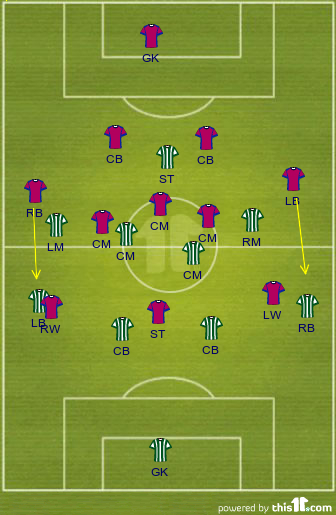 One of the most common reactions to a sending off is to withdraw a striker and form a 4-4-1. This is seemingly the most cautious action as you don't lose any men in defence or midfield allowing your defensive shape to stay the same. However with only one man up front, you aren't threatening at all and this allows the opposition to peg you back, so maybe the most cautious move on paper, isn't actually the most cautious when put into a real life scenario.
One of the most common reactions to a sending off is to withdraw a striker and form a 4-4-1. This is seemingly the most cautious action as you don't lose any men in defence or midfield allowing your defensive shape to stay the same. However with only one man up front, you aren't threatening at all and this allows the opposition to peg you back, so maybe the most cautious move on paper, isn't actually the most cautious when put into a real life scenario.The opposition full-backs can bomb forward and put your flanks under intense pressure since the two centre-backs can deal with your lone striker rather easily, unless he is amongst the best number 9s in the World.
Instead of attacking the wings, the opposition could choose to pack the midfield instead, and dominate the possession stat since they will always have at least one more man in the centre than you, two if they were originally playing a 4-2-3-1 or 4-3-3.
The fact that they have an extra man will apply to all formations, but there's a few formations that deal with the disadvantage better than others and in this 4-2-2-1 I think it could be one of the most effective systems in doing just that.
The 4-2-2-1 - The Best Formation for 10 Men?
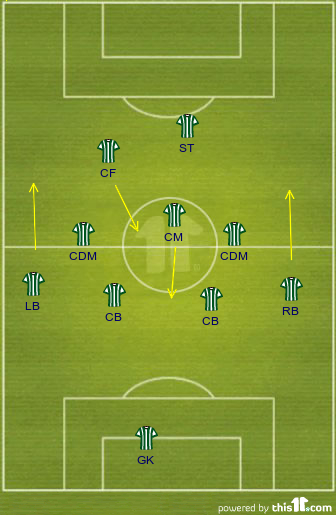 In this formation I think I have found one of the most effective systems in dealing with being a man down. From what I've looked at, it deals with the striker problem as well as what's possible as well as dealing with the numerical advantage on the flanks and in the centre. It requires the players to be versatile however, and capable of switching positions constantly throughout the match. For example, the full-backs need to be capable of playing as a centre-back whilst his side are in possession of the ball, and the supporting striker needs to be able to play a role similar to the false 10, and be competent at winning the ball in midfield.
In this formation I think I have found one of the most effective systems in dealing with being a man down. From what I've looked at, it deals with the striker problem as well as what's possible as well as dealing with the numerical advantage on the flanks and in the centre. It requires the players to be versatile however, and capable of switching positions constantly throughout the match. For example, the full-backs need to be capable of playing as a centre-back whilst his side are in possession of the ball, and the supporting striker needs to be able to play a role similar to the false 10, and be competent at winning the ball in midfield.Defensive Shape
In defence, it forms a 4-3-1-1, with technically 3 CDMs 1 CAM and a striker, however the roles of these players mean that they don't always play in their named position.
The two CDMs play wide, so when the full-backs are put under pressure as shown in the diagram, they can go and support them whilst the CM and CF can fill that midfield gap.
The central midfielder has dropped to form a bank of 3, from this position he can support the defence by marking the opposition CAM if they have one, or simply marking the zone in front of the defense to make sure it isn't taken advantage of by the opposition.
The CF has the role of making sure both defensive midfielders don't have time on the ball by being quick in pressing them and trying to stay between them at all times. As well as this defensive responsibility, he also needs to be always looking for counter-attacking breaks which can be made, therefore effectively, he is a striker whilst having the defensive responsibilities of an advanced ball winner, which helps in making up the numerical advantage.
If under a lot of pressure, the ST can also drop slightly but his primary role is to make sure the CBs don't have time on the ball, whilst
still trying to worry them over a counter-attack.
Shape in Possession of the Ball
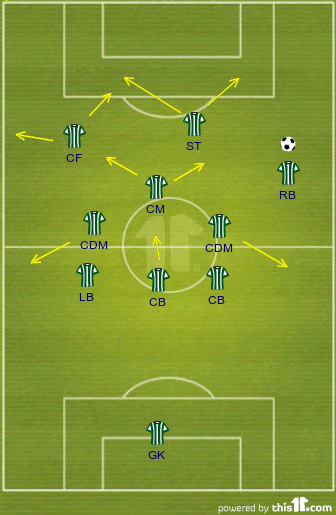 The structure of the side when in possession is relative to the positioning of the ball. Take the diagram for example, as the ball is on the right hand side, the right back bombs down the wing, whilst the left back comes inside and forms a 3 man defence. This seems susceptible to a counter-attack but the two CDMs can cover the empty full-back positions if it's necessary whilst they track back.
The structure of the side when in possession is relative to the positioning of the ball. Take the diagram for example, as the ball is on the right hand side, the right back bombs down the wing, whilst the left back comes inside and forms a 3 man defence. This seems susceptible to a counter-attack but the two CDMs can cover the empty full-back positions if it's necessary whilst they track back.In the 3 man defence, the central defender can push forward slightly to meet the opposition CAM if they have one, or be a passing option in midfield if they don't. The other two defenders will simply be there for pressure relief, something Brendan Rodgers' uses centre-backs for in his tiki-taka system, basically one will try and make himself available for a pass whilst the other stays weary of the opposition striker so if a teammate is pressed heavily, he can simply turn around and pass it to the free man in defence. As the centre-back pushes forward, he creates a midfield which includes 4 midfielders in central areas, so they won't get outnumbered and could still pass the ball around - something nearly impossible for teams to do in other systems.
The CDMs also are simply passing options, they rarely if ever go forward but can move out wide if they need to make themselves space for a pass. They also are there to provide cover for the full-backs should one get caught out of possession.
The central midfielder is a link player between defence and attack, something which is vital in every team. The number 10 would be the main player starting counter-attacks, but he wouldn't roam from position like most number 10s due to the side already being a man down, they can't afford players being allowed to roam the pitch for space, instead a box to box role would work very well.
Up front, the centre forward would be a central winger, making counter-attacking runs predominantly down the left to try and catch the opposition full-backs on the break as they will look to push forward whilst the striker will play his usual game, but with the defensive responsibility of constantly pressing the centre-backs to deny them time on the ball.
The Counter-Attack
Scoring on the break is the best opportunity for a goal in this formation, as it is with nearly every other side who have a man less than their opponents. Most of the counter-attacks would be down the left hand side, as the centre-forward can make quick runs down the flank where the right-back would be out of position whilst still in attack. With the striker going forward as well, it'd ideally create a 2v2 situation should both full-backs be caught out of position. The passes to initiate the attack would come predominantly from the central midfielder, who is as I said earlier, the linking player between attack and defence. Also, if the side posses one with a good amount of pace, a full-back could try and make a run from deep to overload the defence, if he is capable of making up the distance that is.
Thanks for reading guys! Please feel free to Follow me on Twitter if you enjoyed this article! Do you think this formation could work? Give your thoughts in the comments below!

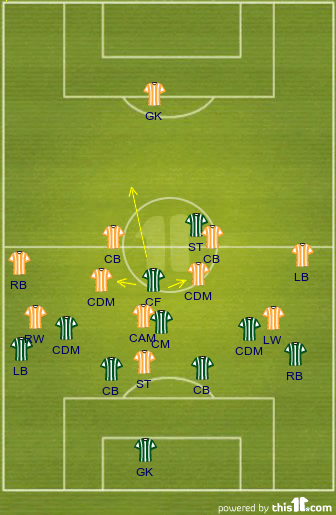
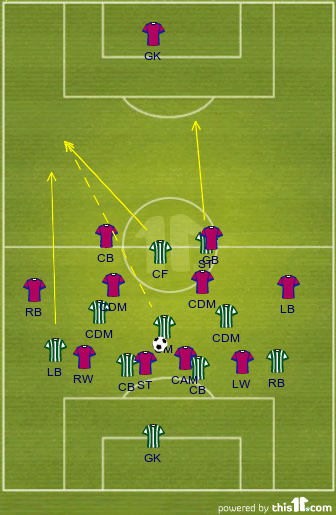
Thanks because I wanna set my team for the match👍👍👍😉😉😉
ReplyDeletegood
ReplyDeleteThanks half my team died so this is really helpful considering we only have ten men 👍
ReplyDeleteyes
ReplyDeleteYo
ReplyDelete